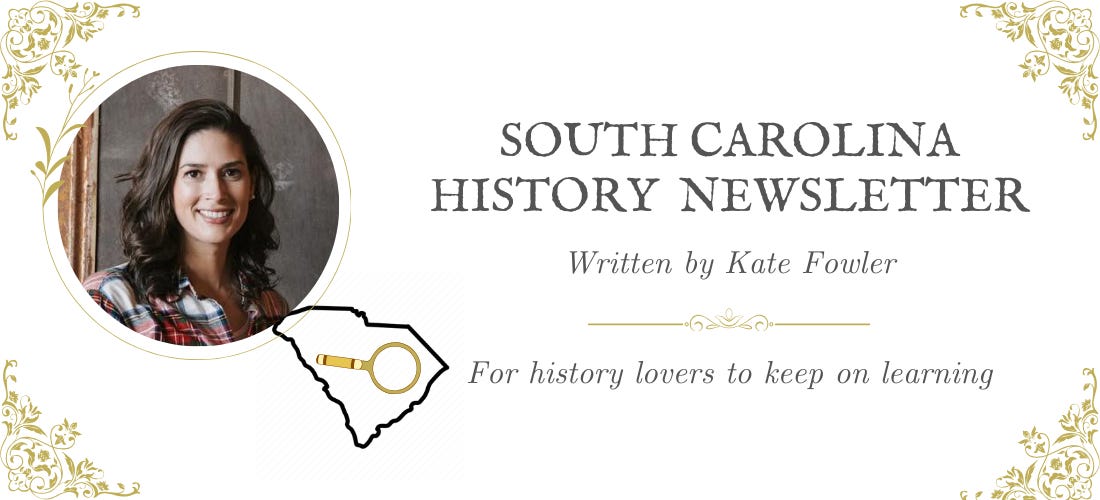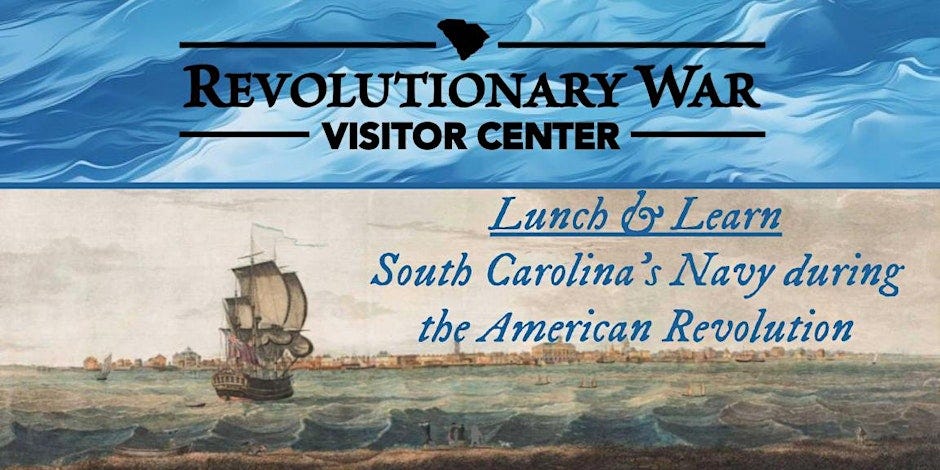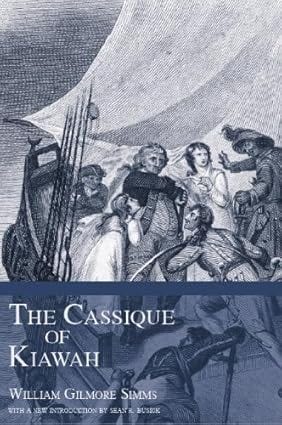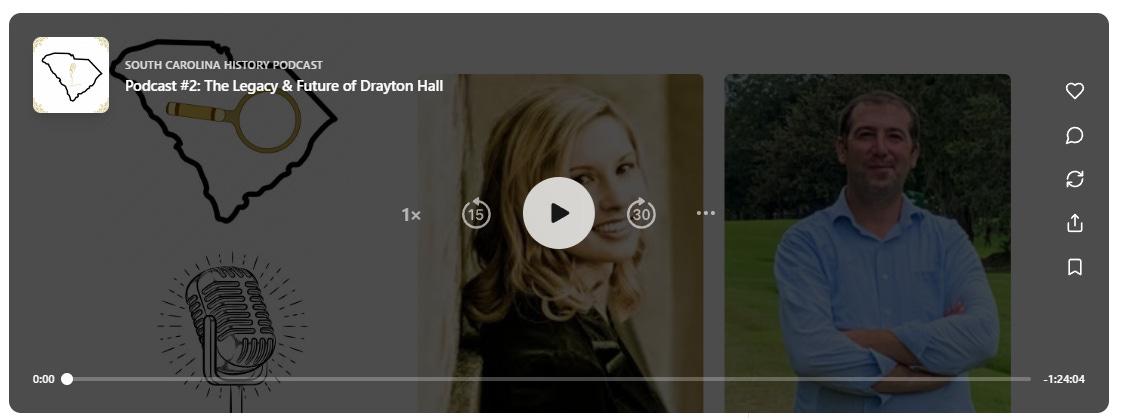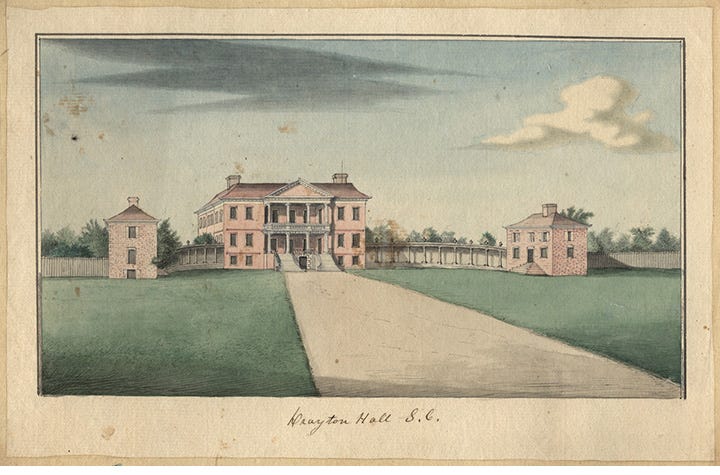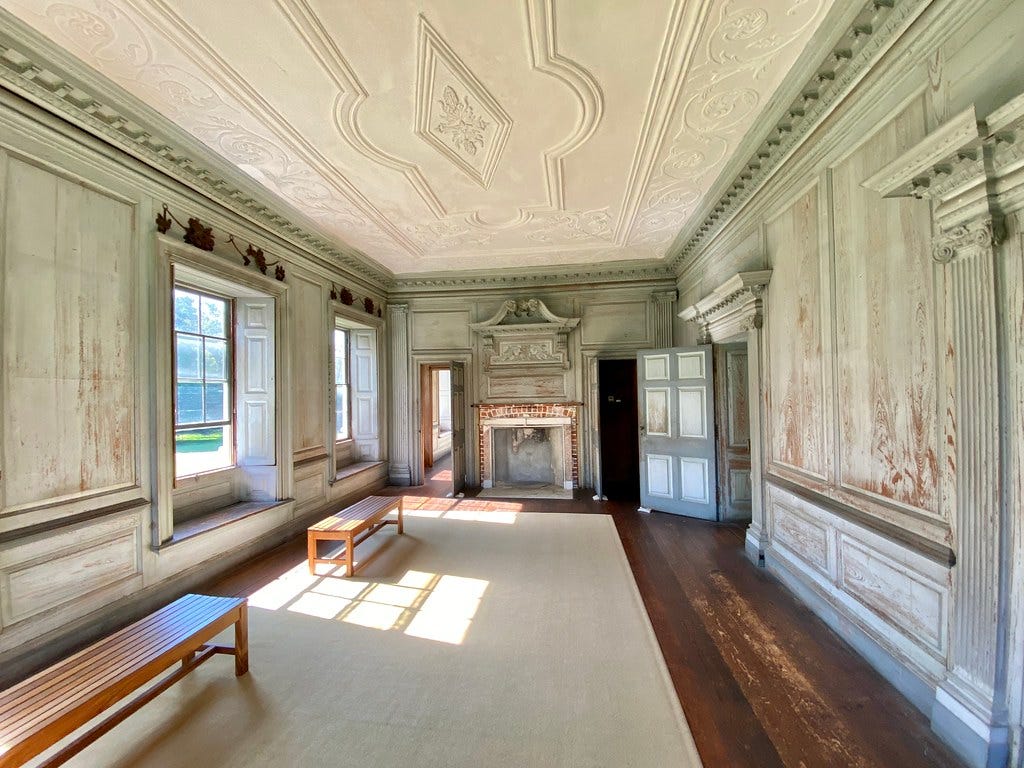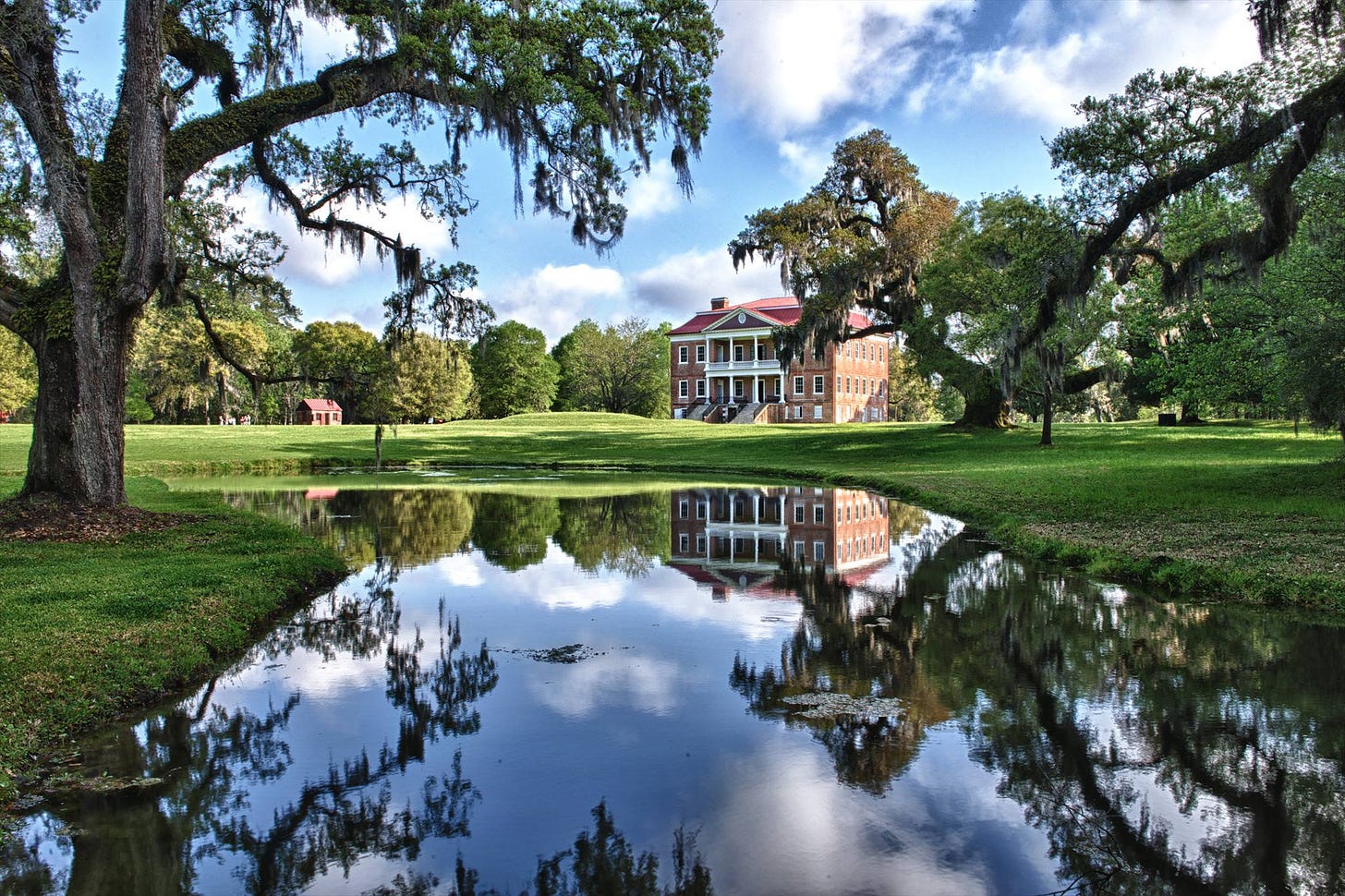#108: Interview w/ Trish Smith and Luke Pecoraro of Drayton Hall, the Casique of Kiawah, and SC's Navy during the American Revolution
For South Carolina history lovers far and wide! Published weekly on Monday mornings. Enjoy weekly SC history articles and upcoming SC historical events.
Dear reader,
Welcome to SC History Newsletter #108!
This week, I was honored to interview Trish Smith (Director of Preservation and Archives) and Luke Pecoraro (Director of Archaeology and Collections) at Drayton Hall for our Podcast #2 of the SC History Newsletter!
Drayton Hall is an 18th century plantation house and property located on the Ashley River about 15 miles northwest of Charleston. From its Revolutionary War history to insights into the lives and legacy of the enslaved workers of the plantation, in our interview, Trish and Luke share their research, stories, and more as we delve into the historical and cultural significance of Drayton Hall — a true historical gem of South Carolina and the United States. I hope you enjoy our interview at the bottom of today’s newsletter.
Note that I am still working on getting the podcast up on Apple iTunes — hopefully soon! But in the meantime, you will notice I’ve added more editing and music for, hopefully, an improved listening experience. Hoping to make the podcast better and better each time.
As always, I’d like to welcome the following new subscribers to our community. Thank you for your interest in South Carolina history!
ginna.stockton
jbgiffin
lifedreamsmesia
wesemory
jmccormick
jturnage
dbmanning1155
lpecoraro
rdneighbors0
wbeacham
connortapp
rhonddt
dfkendall
New friends! If you are new to the newsletter, please note that there are over 100 previous SC History newsletters on topics ranging from the founding of Charleston, sunken Confederate submarines, railroad tunnels filled with blue cheese, and so much more! I encourage you to take a look at our archive here.
Send me your topic ideas: I love it when subscribers write to me! Have a SC History topic or question you’d like for me to write about? Just reply to this email and let me know!
Join us on social: Please join us & keep the conversation going by becoming a member of our SC History Newsletter Facebook Community here! I can’t wait to meet you. :)
If your email “cuts off”: In your email app or website, if my emails “cut off” for you, please click the title of the email and it will take you to the full post on the Substack. I don’t want you to miss any content!
And now, let’s learn some South Carolina history!
Yours truly,
Kate
(Writing from Greenville, SC)
➳ Featured SC History Events
Please note our featured SC History Event below, and click here to visit my SC History Events Calendar that organizes all the upcoming SC history events I have discovered.
Please let me know if you’d like to add an event to the calendar! Reply to this email, send me a note at schistorynewsletter@gmail.com, or use the button below to send me your events.
Event Recommendation of the Week:
Tuesday, August 20th at 12:00 pm | “Lunch & Learn: SC's Navy during the American Revolution” | Revolutionary War Visitor Center | Camden, SC | FREE!
“Joe Long, Curator of Education at the Confederate Relic Room and Military Museum will be share the amazing feats done by South Carolina’s Navy throughout the American Revolution. Don't miss this engaging speaker bring to light this little known piece of American Revolutionary history.”
➳ SC History Book & Article Recommendations
“The Cassique of Kiawah” William Gilmore Simms
(Note from Kate: This book was recommended to our readers by Luke Pecoraro (Director of Archaeology & Collections at Drayton Hall) in our interview at the bottom of today’s newsletter. Luke said in our interview: “William Gilmore Simms was a contemporary of James Fenimore Cooper and he was writing in the 1840s. This book is based on the early history of South Carolina in the 17th century settlement — based on actual events that weave together a novel. It is fantastic for the imagery of what the Lowcountry looked like, and the interactions of natives and newcomers.”)
Here is the publisher’s description:
“Originally published in 1859, The Cassique of Kiawah is the history of how, from humble origins, a little settlement planted between the Ashley and Cooper Rivers began to grow into what would become a proud and prosperous civilization. In this historical romance, William Gilmore Simms, one of nineteenth-century America's greatest novelists and historians, uses extensive research and eloquent detail to achieve a perfect balance of history and fiction.
In 1684, when Carolina was still a new colony, the city of Charleston lacked civilization — no churches, no marketplaces, no religion or trade. A group of settlers (known then as blackguards or ruffians, and among them Harry Calvert, privateer and proud hero of our tale) struggled to build and protect a civilization, a community that would grow to become one of the most loved in the South.
Scarcely available since its publication before the Civil War, The Cassique of Kiawah has been touted as ‘a lost masterpiece,’ and ‘one of the great works of American literature.’ Another critic described the novel as ‘a delightful novel of manners, and a realistic depiction of the early evolution of a society.’”
Do you have a book or article on South Carolina history that has caught your attention? Reply to this email or submit here! We would love to highlight.
➳ SC History Topic of the Week:
In our SC History Podcast #2, we discuss the Legacy & Future of Drayton Hall!
This week, I was honored to interview Trish Smith (Director of Preservation and Archives) and Luke Pecoraro (Director of Archaeology and Collections) at Drayton Hall for our Podcast #2 of the SC History Newsletter!
Drayton Hall is a U.S. National Historic Landmark and 18th century plantation house and property located on the Ashley River about 15 miles northwest of Charleston. From Drayton Hall’s website: “For more than 250 years, Drayton Hall has stood witness to the American South. Among the best and most complete examples of Southern colonial life open to the public today, the property holds a vital educational responsibility. It is also an active archaeological site with an extensive museum collection of rare 18th- and 19th-century objects and artifacts.”
For the first time, we also included reader questions and “Rapid Fire SC Trivia” for our guests. Thank you to Katheryn D., Doug K., Alan P., and Randall F. for submitting questions! I look forward to continuing these segments in future interviews.
Click to listen to our interview:
On the podcast page, you can toggle to the transcript of the episode, and here are some time-stamped highlights of our interview below, including where our reader questions are located:
1:54 — Welcome & Introduction
2:51 — Trish Smith & Luke Pecoraro Introductions/Biographies
5:50 — Trish Smith describes her role at Drayton Hall as Director of Preservation & Archives
8:09 — Luke Pecoraro describes his role at Drayton Hall as Director of Archaeology and Collections
11:48 — Trish and Luke describe the historical significance of Drayton Hall to South Carolina History
19:03 — Luke Pecoraro describes efforts to locate the Drayton Hall slave barracks
22:33 — Trish Smith describes the legacy of Charlotta Drayton and how the property remains so well preserved to this day
26:12 — Trish and Luke describe the most exciting projects they have worked on at Drayton Hall
35:38 — Reader Question #1 from Doug K. from Columbia, SC! “Are the Drayton Hall archives available for public research?”
39:02 — Discussion of descendants of enslaved workers at Drayton Hall and future reunion
40:49 — Reader question #2 from Katheryn D. in Clinton, NY! “What is the evolving conversation, about how to represent the multiple points of view of the many tiers of plantation dwellers and experiences, especially when it comes to the experiences of the enslaved workers who lived and worked at Drayton Hall. How do those stories get represented in tours and the sites literature, and even in the gift shop, etc.?
51:03 — Discussion of the number of enslaved workers at Drayton Hall and the vast Drayton Family empire
53:57 — Reader Question #3 from Randall in Greenville, SC! “If you could recreate an experience in its original form, any part of Drayton Hall, physical or temporal, what would you recreate?” [Trish Smith’s answer]
55:00 — The amazing story of the 1765 watercolor of Drayton Hall
59:00 — What ever happened to the Drayton Hall Colonnade?
1:00:00 — Discussion of the Drayton Hall flanker buildings
1:03:28 — Reader Question #3 from Randall in Greenville, SC! “If you could recreate an experience in its original form, any part of Drayton Hall, physical or temporal, what would you recreate?” [Luke Pecoraro’s answer]
1:06:27 — Reader Question #3 from Alan P. in Raleigh, NC! “What advice would you give to a young person interested in a career and historic preservation?”
1:09:51 – Rapid Fire SC Trivia answers with Trish Smith!
1:14:11 – Rapid Fire SC Trivia answers with Luke Pecoraro!
1:20:42: How can we support the mission of Drayton Hall and the important work Trish & Luke are doing?
1:22:38: Thank you & farewells!
I also want to include some key visuals below that we discuss in the interview:
You can also view the interview on YouTube here:
Have you been to Drayton Hall? Tell us about your experience. We would love to hear about it. Leave a comment below!
➳ SC History Quote of the Week
"Drayton Hall itself, the main house, is very important architecturally. And this is something that we interpret a lot here, is that it is a Palladian building is widely recognized as the first example of this Palladian style of architecture in North America, and it's so ubiquitous now. We see it everywhere — schools, bank buildings, government buildings — places that are really projecting these ideas of authority and power that really touched down first here at Drayton Hall. And we think it's no accident that a man who was making his wealth by enslaving others chose a style of architecture that was made to communicate these ideas. So this is a really big, important idea, not just for South Carolina, but for the whole country and really across the world where we're using this kind of architecture still. It's important for people to understand what that means when we make that kind of choice with this building.”
—Trish Smith, Director of Preservation and Archives at Drayton Hall from SC History Newsletter Podcast #2
➳ Drayton Hall Helpful Links
I always want to improve my work. Answer the poll below to give me your review of today’s newsletter. I also welcome your suggestions for new content! Simply reply to this email with your ideas. Thank you!




